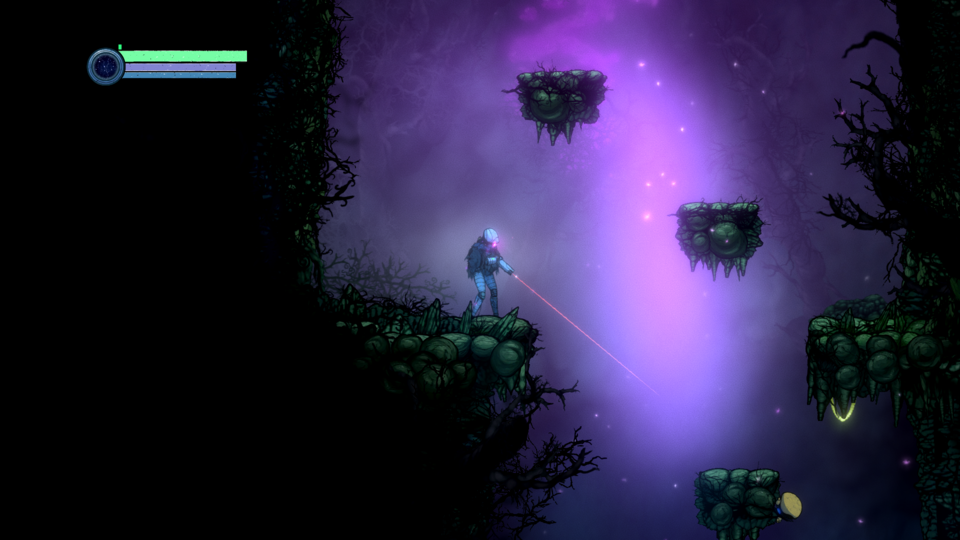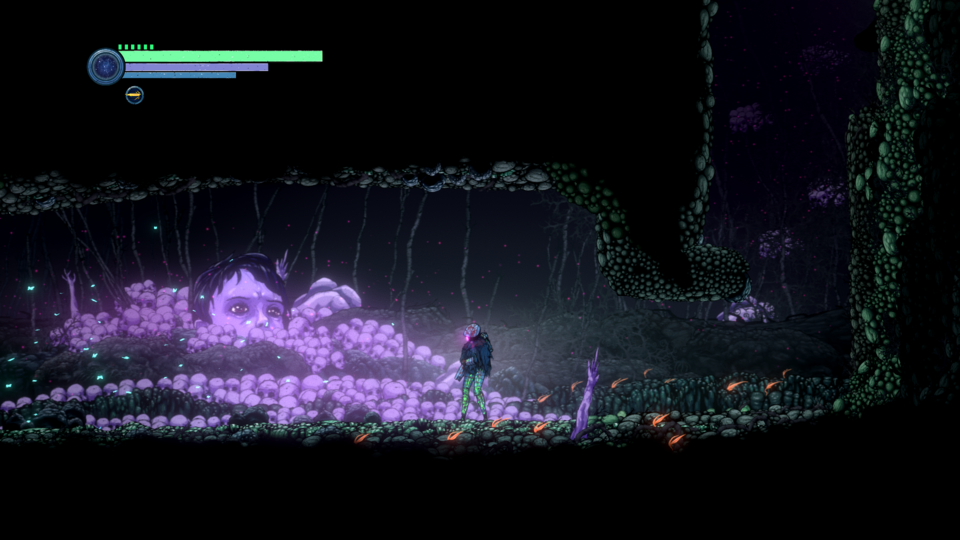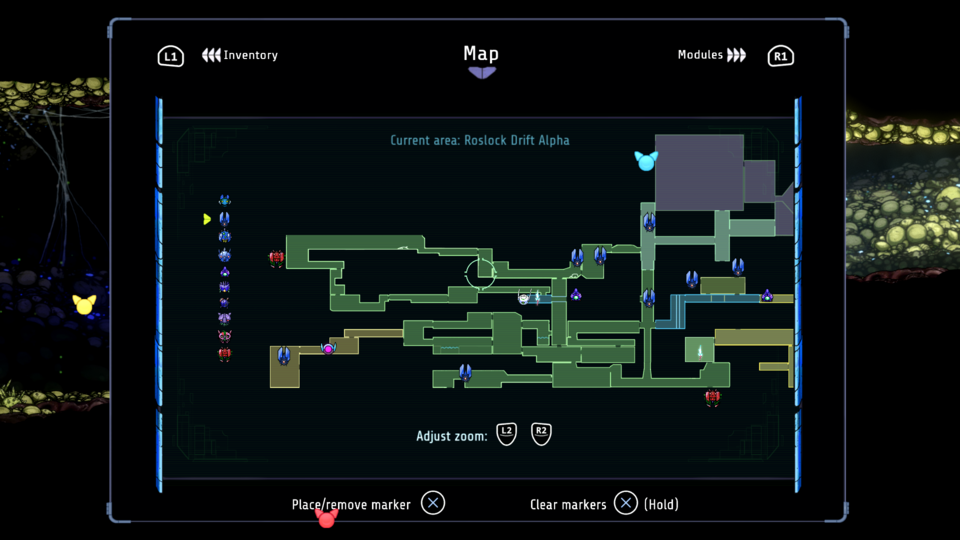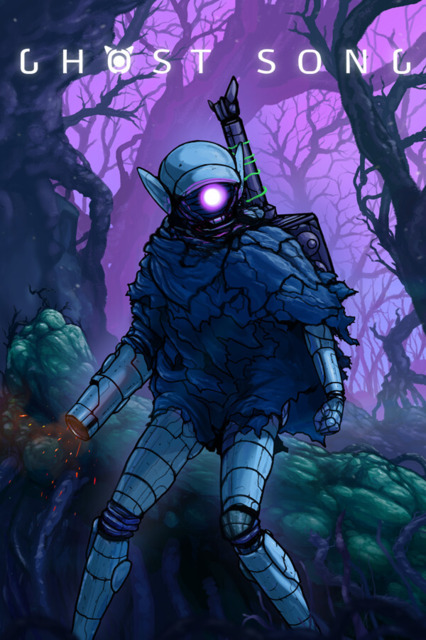
- Game: Old Moon's Ghost Song.
- Release Month: November.
- Quick Look: N/A.
- Started: 13/12.
- Completed: 15/12.
Turns out this free Game Pass I lucked into has more than a few explormers available on it, so you better believe I'm going to get through as many as I can before Microsoft's generosity wears out and I have to go back to buying games like a sucker. Ghost Song is an atmospheric (way more on that later) explormer from Old Moon helped into being through Kickstarter. It concerns an anonymous, amnesiac woman trapped in an exosuit that vaguely resembles the one Leia wore in Return of the Jedi. She chances upon another group of survivors on a planet that has been wracked by some mysterious biological apocalypse from the distant past, surrounded by an EMP field that knocks out any ships that get too close. Running around collecting the necessary parts to repair the Gambler, the ship belonging to said survivors, the player learns more about the planet's history and considerably less so about their own origins, which are left more to interpretation by the game's end.
So, yeah, we're congregating yet again at the Church of Soulslikes for this one, which is starting to become more the rule than the exception for modern explormers. Not that I mind, of course: I'm still plugging away at Elden Ring between these smaller GOTY Indies, and even if that game has three hundred hours of content I still can't get enough of that dripfeed of lore morsels, or loresels, between some very punitive game design mechanics and bosses alike. Ghost Song settles into that uncanny valley between a more morose Soulslike such as Hollow Knight—Ghost Song has a similar system of equipping "modules" using a limited skill point pool, able to adapt to a variety of situations and environments—and the sublime Super Metroid, from which it borrows the basic structure of exploring the underworld of a planet very much hostile to anything with a pulse.

We'll start with the strengths. Ghost Song has a wonderful sense of atmosphere, helped considerably in part by some very intense and crunchy sound design: its biologically-active areas will hum, gurgle, groan, suppurate, and otherwise make gross noises as you pass through, like you're strolling through the belly of a beast, while the more chill areas will either let the silence wash over as a relief from the teeming life found elsewhere or otherwise hit you with one of its laid-back, ambient tunes as you take a moment to collect yourself. The sound design is especially potent whenever you walk anywhere: whether that's the squishy grounds of the bug-infested Roslock Drift zones or the metallic tin of mechanical areas like the Junkpit or the interior of the Gambler, your footsteps are a constant companion in the oppressive sounds of the underground. It lends itself well to the feeling of heading deeper into territory that threatens to overwhelm your senses, your mind making every danger klaxon it can like it's forgotten you're just playing a video game, and provides the otherwise visually similar areas some amount of distinctiveness.
The game has a stronger than usual focus on character moments and worldbuilding, being the first Metroid-type game to introduce a bizarre alien world full of unknown monsters and dangers and actually make some effort towards explaining how it came to be that way (and it gets pretty damn wild too; some definite shades of Iconoclasts's ambitious sci-fi table-setting). Most of these lore drops come courtesy of NPCs you meet, and while the game does do that annoying Souls thing of having these NPCs wander around the world map thus making it easy to lose track of where they might have gone, you usually get something out of finding them. Saymund, an itinerant android who has been on the planet for much longer than any of the survivors, is a particular font of information about the history of that place and is worth talking to whenever you should be fortunate enough to encounter them. Most of the other NPCs are sitting around close to Gambler itself, ready to share their thoughts and worries whenever you stop by to avail yourself of the vendor there or have a new ship part to return. NPCs switch places after each ship part is delivered—the closest the game has to a chapter system—and will usually have new topics to discuss. You end up growing close to many of them as they talk about their lives prior to their current predicament and what they hope to do once they've found a way off-world; the frazzled mechanic Roper, for instance, lets slip that he used to be a professional tap dancer. Regarding those ship parts, the game lets you know the location of all five as soon as you've discovered the survivor camp: the player's free to chase these targets in any order they wish (though the part represented by the green icon—found the furthest away, inconveniently—is recommended due to a valuable traversal-enabling ability you'll acquire along the way). Having the structure be a little more open like this means you're not going to get punished, say by a massive difficulty hike or a physical impasse, for deciding to explore in any direction you wish.

All right, strap yourselves in because we're about to mosey on down to Kvetchtown. There's much about this game that profoundly irritated me, and these annoyances continued to pile on the further I played. The first and most evident is the iffy combat, which attempts to find that balance of long-range and close-up weaponry with a fast dash move that you acquire fairly early in that, theoretically, should let you zoom through enemies so they don't trap you in corners as they're often very big and the level geometry pretty claustrophobic. In practice, the dash more often than not will faceplant you directly into an enemy's sprite causing a considerable amount of contact damage that has very little in the way of an invulnerability buffer between instances when that damage is applied, so its usage is less reliable than you'd hope. Thanks to a large assortment of modules and weapons, it's not difficult to find an arrangement that is brutally overpowered if the combat's really dragging the experience down: I certainly didn't feel guilty smashing that difficulty curve to rubble with a health-sapping melee build given the frequency in which I was swarmed by enemies and "bumped into" to death. Worth noting here too that, in true Souls style, you lose all the currency you had on you (spent on items and experience levels both) until you can recover it from where you died and deaths also carry a semi-permanent malus to your maximum HP that you can cheaply fix but not always conveniently. Chances are, you got beat by a boss a fair distance from a place where you can repair your health gauge and that means having less and less health for each subsequent attempt until you're either forced to bail and head back to a place where you can recover, or doggedly persist with an ever-decreasing HP total for an ever more frustrating experience. (One piece of praise I'll offer to the combat system in this game is that it does something so ingenious I'm shocked I've never seen it used before: your little Mega Man blaster arm rifle will overheat after sustained fire, causing the fire-rate and damage to drop off considerably until it cools back down again; however, the red-hot barrel becomes that much more painful as a melee weapon with that bonus heat, so clubbing an enemy while it's in that state does way more damage than usual. Thus, you're encouraged to shoot until your gun is glowing hotter than the sun and then applying a superheated beatdown on your foes in the cooldown interim between salvos. Changing the rate at which this heat builds up effectively means prioritizing melee over gunplay, or vice versa.)
Speaking of heading back anywhere, the map is fairly huge and the fast travel points few and far between, so it takes a while to get places, disincentivizing a whole lot of backtracking given the distances involved. Best of all, whenever you recover a ship part from one of the furthest terminal points in the world, you're required to walk all the way back to the survivors' camp with it: that means absolutely no fast travel, all the while being assaulted by some tougher enemies that only spawn in the world whenever they notice the ship part on your back. This little wrinkle doesn't add anything besides extra minutes to the game timer (did I mention yet that one of the achievements is for completing the game in under three hours?) so I'm not sure what role in improving the overall game experience this inconvenience serves. Then we have the mapping tools: rather than give you automatic map icons for places of interest, the player is given a bunch of colorful alien markers that they can assign their own meaning to whenever they place them on the map. A little blue guy with wings, for example, might work to indicate areas where you need a longer or higher jump to reach a treasure or path, though the rest of the markers don't really have anything similar to latch onto as intuitive shorthand for a missing upgrade. Even for as unhelpful as this system is, however, it's made even more useless by the way the game will actually randomize the markers you placed each time you boot the game up. Just picked up the double-jump? Better hope all those areas you marked before still have the same little wingaling dude, otherwise it's a crapshoot where you can use it. Finally, there's the achievements. I try not to rag on achievements too much because they're usually the last consideration in any development cycle, but we've had the damn things for over 15 years now so it's expected to get them right. Having separate trophies for playing on the hardest difficulty, playing within a time limit, and playing without dying once is what I call the Unholy Shitfecta: a trilogy of mutually-opposed goals that would necessitate at least two if not three complete playthroughs to earn in full, even though you can get the rest of the game's achievements in a single run. An exasperating misstep in an ocean of same.

Even so, there's much that can be smoothed over if the game has a strong personality and aesthetic to fall back on, and Ghost Song's compassionate character moments, some bold worldbuilding that you have to work to uncover, and a really potent sense of atmosphere are typically aspects of a game that stick with you long after all its smaller, moment-to-moment failings pass from memory. In that regard, Ghost Song occupies a similar slot in my brain as Outer Wilds: a game that, were I to go back to it now, I would rapidly get enervated all over again by just how irksome it was to get anything done in that game, but as it is—having created plenty of distance away from that playthrough like it was a star about to explode—it stands tall as a wildly imaginative game and universe full of memorable moments and dripping with such style as to persevere in the memory banks forever. I may well forget all about Ghost Song by the time I've played another half dozen explormers, but if it does stick around I'll probably recall the ways it aimed big with its presentation before I remember how it used to bug me incessantly. I realize this doesn't sound too much like a recommendation, but I'd suggest giving it a shot anyway. Sometimes a game can be greater than the sum of its parts, after all.
Current GOTY
- Elden Ring
- Tinykin
- Tunic
- Signalis
- Return to Monkey Island
- HoloCure
- Ghost Song

Log in to comment